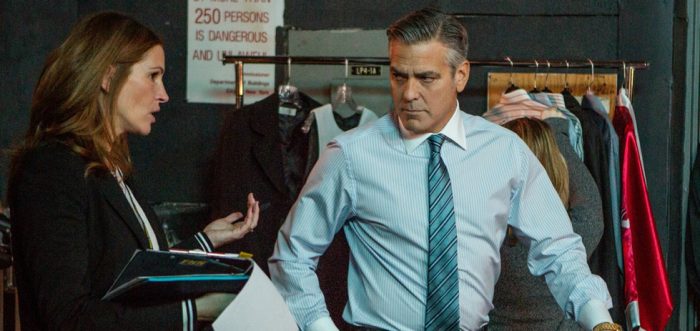
Jodie Foster’s Money Monster presents itself as a familiar but untraceable trope; the hostage drama occurring live-to-air. Is it going to take the route of Sidney Lumet’s Network and build a critique of itself? Or are we heading towards personal reveals and a depressing denouement, a la Costa-Gavras’ Mad City or any number of other media-hostage thrillers? In the first act at least, Money Monster goes for the real meat; a full-throated description of the financial crisis mechanisms that have devastated much of middle America and dozens of countries around the world.
Contemporary thrillers hope to act as translations for sometimes impossibly vague problems. The familiar and generic tropes combine with new reference points to give the dramatic structure a new cohesion. Broad social anxieties – family breakdowns, rip-offs, injustices at work, unjust wars – often have no coherent shape until they’re humanised. In thrillers, they take the form of desperate losers, people pushed to the limit, and the drama of a hostage who stands in often as a Greek chorus, translating the injustice for characters and audiences.
In Money Monster, the investment dupe Kyle Budwell (Jack O’Connell) buys stock from a tabloid television manipulator (George Clooney), kept in line by a long-suffering producer (Julia Roberts). The company crashes overnight and the dupe wants answers, gets a gun and bomb and sets about getting them in short order by hijacking the broadcast. From that point, forget the plotholes and enjoy the monologues. So far, so good.
Yet Money Monster has a bigger translation problem. The financial crisis of 2008-2009, aka The Great Recession, is proving to be tender, sluggish material for contemporary Hollywood. Films like Margin Call and Oliver Stone’s Wall Street: Money Never Sleeps have taken the high drama route, while the more recent Wolf of Wall Street and The Big Short are best described as dark comedies and documentaries Capitalism: A Love Story and Oscar-winner Inside Job play the straight description. The financial press in the US favours Curtis Hanson’s Too Big to Fail as providing the densest and most intelligible view into the crisis. But it is Lauren Greenfield’s 2012 documentary The Queen of Versailles that cuts to the quick for many of us – morbid wealth turned to shit and ash, human habits a constant swivel for the drama of both extremes.
Money Monster wants to be a film about the Great Recession, but cannot help but head further into territory that will make it more readable – a grand scam, secret double-crosses, toppled giants, the charismatic but compromised television punter. George Clooney and Julia Roberts phone it in, the film’s tension held together by phone calls from Caitriona Balfe and Dominic West’s characters. The rest falls away, deflated less by pacing or plot but by the unworkable fogginess of the financial crimes that underpin the drama. None of the films above – and certainly not Money Monster – successfully put a face on the ‘true’ drama that Foster’s protagonist Kyle Budwell is supposed to front.

Stories about the real horrors of financial collapse often go this way, giving way to obviousness to avoid collapsing into the abyss of the required dense narratives. The dramatic element for the traders in this type of film is almost always clear: the incredulous sense of easy money, the disbelieving young stud coming into an easy million, the fierce panic as hapless regulators get their shit together. This is the backbone of most films about high finance, thrillers or otherwise – winners and losers, morally cleansed by their upheaval. Some of the more fascinating films about the mortgage crisis and their victims – such as 99 Homes and Lost River – dig beneath the surface in an attempt to visualise and narrate an element of the cataclysm.
In our world there is no deus ex machina of the immediately legible, singularly responsible villain like there is in Money Monster, only a broad sense of injustice underpinned by legality. Among the worst of the worst companies who keep their business legally watertight at every stage but continuously profit from distressed and subprime capital is Lone Star Capital, trading sometimes as LStar Finance and a myriad of other names – relevant here because they are the primary fund producer for Money Monster itself. IBIS, the fictional company at the centre of the drama in Money Monster, is caught up in high-frequency trading (a type of trade that is poorly but mostly accurately explained in the research phase of the film) which is very different to Lone Star’s structural investments. However, both the fake and the real company specialize in betting on the poor’s inability to fend for themselves, and win every time.
Lone Star and LStar not only were involved in the financial side of Money Monster, but are a principal investor in many Sony Pictures films as of April 2014. Since then, Sony (through Columbia) have had a hand in Pixels (Chris Columbus, 2014), Concussion (Peter Landesman, 2015), The Fifth Wave (J Blakeson, 2015) and Grimsby (Louis Leterrier, 2016). There was LStar money in The Interview (Rogen/Goldberg , 2014), which ended up causing an international incident. Whatever the finer points of their deal, the payoff would be the box office success of films like 22 Jump Street (Lord/Miller, 2014) and The Equalizer (Antoine Fuqua, 2014) among the moderate gains of The Amazing Spider-Man 2 and a few others. The cavalier fund manager Walt Camby (Dominic West) in Money Monster isn’t portrayed in any way close to Lone Star’s figurehead vulture capitalist John Grayken, so as a critique it’s merely an uncomfortable allusion that at best verges on weird: one of Grayken’s private residences is the massive manor house from Richard Donner’s original version of The Omen, a fine place as any to oversee mortgage crises the world over.
Films like Money Monster ultimately fail to tell the story of the financial crisis with depth and coherence because narratives of investment trading lack a functional, concrete visual template. The swindles are too massive, too complex and too multi-layered to frame as conspiratorial. Money Monster goes the easy route; giving you the exasperated cops, the jeering crowd, the sneering boss, the whirling mise-en-abyme of the media – everything you need to signpost your way to moral clarity. But it stops short of a proper reveal; Foster can only give us the sketch of desperation, single agents manipulated by the market, and the invisible hand is an evil cynic after all. By the end, even the Bourne films offer up more critique of their subject matter.
To render finance as cinematic, Foster’s hostages and guns and bombs are needed to clear the very real fog. A bit of sinew and blood makes sense of what we know are the continent-sized rip-off schemes happening around us. Yet the payoff never comes. The detonator never clicks. Kyle Budwell is supposed to act as a cypher for the anguish of the crime, but the real results of financial horror are far uglier. For small towns in the United States, Kyle Budwell is a power fantasy, not a warning. In the shadow of the Great Recession, the power fantasy coalesces in a vote for Donald J. Trump – a more complete and timely revenge, perhaps, than the gun being turned onto the camera. Whatever fable Money Monster wanted to construct, it remains comforting; violence is simply not cathartic enough these days.
Christian McCrea is an academic and writer. Follow him on Twitter at @christianmccrea
